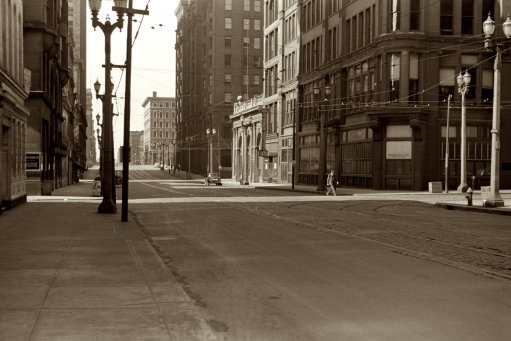On the Road: Columbus, Ohio
Click on Thumbnail for MapUnfolding the Map
Sal and a situational girlfriend (i.e. bus traveling companion) make it to Columbus, where they part ways and he continues his journey back home. While her path diverges into the unknown, we'll keep following Sal to the conclusion of his. Click on the map to get your bearings.
Book Quote
"She was coming from Washington State, where she had spent the summer picking apples. Her home was on an upstate New York farm. She invited me to come there. We made a date to meet at a New York hotel anyway. She got off at Columbus, Ohio..."
On the Road, Chapter 14
 1940s or 50s aerial view of Columbus as it looked when Jack Kerouac came through
1940s or 50s aerial view of Columbus as it looked when Jack Kerouac came through
Columbus, Ohio
In 1995, my fiancee, who was studying journalism at Marquette University, went to Columbus for a summer for an internship at the Columbus Dispatch. She spent her time copy editing, usually getting home late at night to her apartment in Columbus' German Village. We were due to be married that September, but she wasn't getting back to Milwaukee until August, so a large share of the wedding responsibilities were going to fall to me. As most women understand, men aren't usually known for their involvement in planning weddings, and for me it seemed like a daunting task. I got her settled in the German Village, and after a weekend helping her get situated, I drove away feeling quite lost and lonely and aware of the responsibilities that I would have to shoulder. I hoped I wouldn't screw them up.
A year before that, she had gone to Topeka, Kansas as a summer intern for the Topeka Capital-Journal. It was her first internship, and really, her first summer away from me since we had started dating. I wasn't feeling as lost or lonely at that time, but she certainly was. She got settled in an apartment with someone she didn't know, and I spent a couple of nights with her before driving back. She was very nervous, couldn't sleep, and actually made herself nauseated with worry over her internship and my leaving. She cried when I headed back to Milwaukee in the small van we rented to take her bed and other things down to Kansas, but she soldiered on and had a successful summer.
I mention these partings simply because human contact in a time of change seems so very important. The emotional support is often needed and wanted by people undergoing change or facing uncertainty. I can think of other times when my wife and I parted, such as when I made a four week journey to Bangladesh as part of my Masters program, or when she went to India for five weeks as part of a Rotary International Group Study Exchange, or when I most recently in 2008 spent five weeks in El Salvador at a language school. The support she gave me, and the encouragement, was invaluable, and especially before my foreign trips where I was very nervous about heading into the unknown of a developing country alone.
Yet I often wonder if I would have felt so much apprehension, loneliness and even regret if I hadn't had that support. Would I have just plunged in, devil-may-care, because there was nobody holding my attention, nobody I had to worry about, nobody who would worry about me? I wouldn't trade my wife's worry for me for anything because it makes me feel special and loved. But, how would my attitude have been different were I unattached?
I ask because clearly, Jack writes Sal's character at times as that same damn-the-torpedoes type of adventurer who has no attachments or worries, who takes off at the drop of a hat when he feels like it. But at other times, he shows Sal to be a man of attachments; a man who pursues Dean Moriarty all over America, who shows the very human emotions of regret and wistfulness as he leaves Terry, and who seeks out female companionship on a bus ride across America back home. I suppose we all have these two aspects of character as we travel to new places and search the unknown. Mark Twain once had Huck Finn state his desire to "light out for the territories," and I often have that urge to just get myself up, out and on to exploration. But as I grow older, and my attachments deeper, I have a better sense of what I leave behind when I go, and that makes it harder.
If you want to know more about Columbus
the 270-a Columbus blog
CMH Gourmand
Columbus' Best Blog
Columbus Convention and Visitors Bureau
Columbus Dispatch (Newspaper)
Columbus Foodie
The Other Paper
Wikipedia: Columbus
Wikipedia: German Village
Next up: Pittsburgh, Pennsylvania
 Columbus,
Columbus,  Jack Kerouac,
Jack Kerouac,  Ohio,
Ohio,  On the Road,
On the Road,  Sal Paradise,
Sal Paradise,  beat,
beat,  beatnik,
beatnik,  bus,
bus,  bus travel in
bus travel in  On the Road
On the Road 






